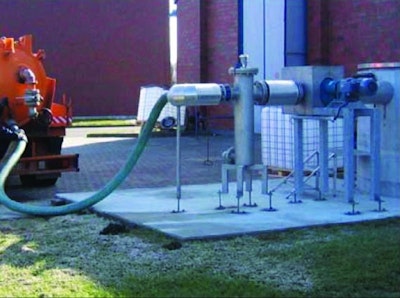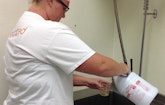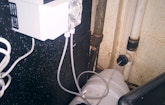Interested in Dewatering?
Get Dewatering articles, news and videos right in your inbox! Sign up now.
Dewatering + Get AlertsDewatering system designed to treat grease trap waste
Problem: The City of Sheridan, Wyo., did not have a grease trap disposal facility within 150 miles and local restaurant grease traps were overflowing into the city sewer. The plant was equipped for sewage treatment using activated sludge aeration and a biosolids belt filter press. However, the fat, oil and grease plugged the digester and belt press.
Solution: Sheridan chose a Lakeside Raptor SAP screen combined with an Auto-Vac sludge dewatering system from Alar Engineering Corp. The Raptor removes debris and inorganic solids, and the Auto-Vac automatically pH adjusts, adds polymer treatment and filters the grease trap wastewater. Effluent water is sent to the plant, while filtered water is used for the belt press washdown process, landscaping and non-potable hose reel system. The treated and dewatered sludge is transported to the city landfill to be mixed with green waste for composting.
Result: The plant is classified as Level IV. The grease processing facility is available for all restaurant grease producers. This facility and its technology is a first in Wyoming and benefits Sheridan’s customers by keeping their systems clean and flowing. 708/479-6100; www.alarcorp.com.
Procedure reduces grease theft by 90 percent
Problem: The owner of All Valley Environmental, a grease collection service in Fresno, Calif., partners with restaurants in the Central Valley to recycle used cooking oil. Together they dealt with a number of grease-related issues such as theft, employee safety and compromised sanitary issues. The revenue loss alone from evening raids reached the tens of thousands of dollars annually. The number of worker’s compensation claims rose as employees slipped on grease-laden floors in the kitchen.
Solution: A systematic solution utilized Consolidated Fabricators Corp. products. For some customers, grease was stored indoors in a smaller, lightweight Eco-Tub tucked under the sink. The maneuverable unit can be rolled from the fryers for ease of use. Grease would not end up on the floor, creating a safer, cleaner work environment and mitigating waste. For those restaurants with outdoor steel containers, grease can be transported with a lightweight portable grease caddy with bogie wheels. The outdoor grease container is secure with steel construction and lockable bar gate.
Result: Having the equipment and a procedure means a smooth operation, theft is deterred and employee accidents from grease spills are nonexistent. Restaurant employees have the equipment they need to effectively transport and house grease in a safe and secure manner so the hauler can collect it. 800/635-8335; www.con-fab.com.
Rotary lobe and grinder pumps enable grease receiving
Problem: The wastewater treatment plant in Löhne, Germany, wanted to feed sand trap grease to its digester in order to increase gas production. The fat/water mixture is delivered by tanker truck to the plant and needs to be transferred to the digesters efficiently. The material can vary in viscosity and contains various solids such as Q-tips, hair and pieces of plastic.
Solution: A Boerger Rotary Lobe Pump driven by a hydraulic motor is installed on the tanker truck. The medium is pumped from the tanker by hose and passes through a debris collector, and a Boerger Multicrusher twin-shaft grinder driven by an electric motor. Larger solid material is caught by the debris collector, and the Multicrusher breaks apart the remaining solids and homogenizes the mixture before the material flows into a grease container. Another rotary lobe pump, this one electrically driven, transfers the mixture from the container directly into the fat digester.
Result: The equipment transfers the material at flow rates over 400 gpm and empties the 800-gallon capacity tanker truck in minutes. The maintenance-in-place design allows all equipment to be easily maintained without disconnecting the piping or drive systems. The two rotary lobe pumps and the Multicrusher have many parts in common, which makes ordering and stocking spare parts easy. 612/435-7300; www.boerger.com.
Product assists in maintaining manufacturing lines at cookie plant
Problem: Darrell’s Septic Service would be called out to the Best Maid Cookie Company in River Falls, Wis., three to four times per year for several years to deal with grease buildup in the manufacturing plant. Manufacturing lines would often back up, shutting them down. Backups also caused odor issues.
Solution: Darrell’s chose Lenzyme Trap-Cleer Liquid 60X to help maintain the lines.
Result: Darrell’s reports the lines are staying clean. There are no odors. The company continues to order Trap-Cleer through Darrell’s and uses the product on a scheduled basis throughout the year. 800/223-3083; www.lenzyme.com.
Concentrate helps restaurant reach permit levels
Problem: A large restaurant in Alpharetta, Ga., used a 2,000-gallon in-ground grease trap with no effluent filter. The restaurant was exceeding permitted discharge levels for FOG/BOD, with high FOG causing buildup in downstream lift stations.
Solution: REX-BAC-T Technologies assisted the restaurant with a goal of reducing BOD and FOG using a liquid biological concentrate. No enzymes were used throughout the study. An automated dosing system was installed, and Bio-G2 Series concentrate was injected into restaurant drains on a daily basis. Effluent samples were captured at different time intervals and sent to a third-party laboratory for analysis.
Result: After one week of treatment, TSS was reduced 74 percent, oils and grease 42 percent, BOD 26 percent and COD 31 percent. After two months of treatment, TSS was reduced another 66 percent, oils and grease another 68 percent, BOD another 46 percent and COD another 49 percent. 888/886-1461; www.rex-bac-t.com.









